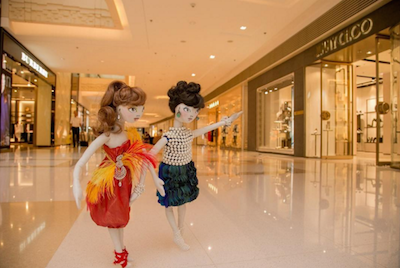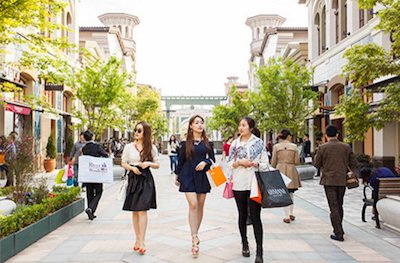Chinese consumers are becoming more selective in their purchases, trading up from mass to premium labels as their confidence grows.
A new McKinsey report, “The Modernization of the Chinese Consumer,” found that a significant portion of the population would raise their spending on apparel, travel, personal care and other services if their incomes grew. Representing positive news for international companies, the preferred premium brands in categories such as cars, skincare and fashion remain foreign brands.
“The premiumization trend is even more relevant for the premium segment rather than the luxury spend (driven by the middle-class rather than the ultra-rich),” said Daniel Zipser, partner at McKinsey & Co. and co-author of the report. “So, the question for the luxury players is how to offer a premium product, which is accessible and allows trade-up for the middle-class.”
McKinsey’s 2016 China Consumer Report conducted 10,000 in-person interviews with individuals aged 18 to 65. Respondents came from 44 cities, representing China’s various regions and tier cities.
Confidence boost
As salaries rise and unemployment remains low, consumers confidence in China has improved. As a result of their positivity, volume growth in mass segments, such as food and beverages, has flatlined while premium products race ahead.
When presented with a hypothetical boost in income, the top three product categories that consumers would be likely to grow their spending on were food, apparel and health care items. For services, leisure and entertainment, travel and personal care, such as spa visits, were at the top of the list.
Chinese consumers have become more brand loyal, with many unwilling to look outside their consideration set. For apparel purchases, the 61 percent of consumers who stuck to a set list of brands in 2011 rose to 70 percent in 2015.
For brands looking to enter consumers’ list of possible choices, the task is becoming more difficult. It is now harder to sway new potential customers with promotions.
Chinese consumers are still concerned with accruing wealth, but having a happy family is a growing interest. Since 2009, approximately half of respondents have agreed that being successful is hinged on being rich. In the meantime, the relation of a happy family to success has grown from 62 percent to 75 percent in 2015.
While this has an impact on how consumers live their lives, it also extends to the manner in which they shop. Sixty-four percent of consumers consider shopping to be one of the best ways to spend quality time with family.
The biggest winners are shopping malls, which attract shoppers away from big box stores with their blend of retail, food and entertainment in one place.

Elements Hong Kong Kouklitas dolls
A desire to spend time with family is also impacting travel plans. Forty-five percent of international trips were taken with relatives in 2015, a growth from 39 percent in 2012.
While away on their average of 1.5 trips a year, Chinese consumers are typically looking to shop. During the holidays, 79 percent went shopping and 29 percent go so far as to select their destinations based on the shopping possibilities at the locale.
The 70 million Chinese consumers who travel internationally make about a quarter of their total annual purchases surrounding their vacations. Of this, half is allocated to travel expenses, with the other half going to shopping.
While travelers most often purchase clothing and beauty products, half of all watch and handbag purchases are made while on holiday.
Trend setting
Chinese consumers are faster at adopting new products, services and retail possibilities than those in more developed nations. For one, 25 percent had embraced mobile payments by 2015, up from none in 2011.
Despite its status as an emerging market, China’s ecommerce business is almost as strong as that of the United States and Europe, around $618 billion in 2015.

Burberry flagship in Shanghai’s Kerry Centre
The physical store is still an important part of the purchase process, and consumers in general tend to be more satisfied with bricks-and-mortar retail than ecommerce. Still, online stores are catching up, as its customer approval grows while in-store gratification slows or falls.
Positive outlook
While Chinese consumers are largely optimistic, it is important to identify the various geographical pockets that show the most promise. McKinsey identified clusters of anywhere from two to 84 neighboring cities that share similar governments, economies and consumer behavior.
Consumer confidence in Mainland China is showing signs of growth, while Hong Kong consumers are expected to be more conservative in their luxury spending, according to a new report by Ruder Finn and the Consumer Search Group.
Forty-two percent of Mainland consumers expect to raise their luxury spending in 2016, but just 25 percent of Hong Kong residents say the same, whereas 30 percent said they would be spending more in 2015. However, while Hong Kong consumers may be curbing their spending, they are still interested in exploring new luxury brands and services, and the luxury industry should not discount the island (see story).
Even with a faltering economy, Chinese consumption is projected to rise $2.3 trillion by 2020, according to new research by Boston Consulting Group and AliResearch Institute.
Households with disposable incomes of $24,000 or more will drive 81 percent of consumption growth through 2020, creating demand for high-end goods and services. With rising incomes, a younger generation gaining spending power and growing ecommerce expenditures, brands will need to adjust their strategies (see story).
“[The strong consumer confidence] indeed came as a surprise to us,” Mr. Zipser said.
“The consumers do not feel the economic turbulence yet themselves as unemployment remains minimal and wages continued to increase substantially even in 2015—and continue to do so in 2016,” he said. “So, consumers do not feel it in their own pockets yet.
“Also, there are large and increasing regional differences. Economically weaker regions – particularly in North Eastern China – actually have seen a significant decrease in consumer confidence, while other parts of China have seen an increase, leaving the country average largely unchanged.”
from Apparel and accessories – Luxury Daily http://www.luxurydaily.com/50pc-of-chinese-consumers-seek-best-most-expensive-product-mckinsey/
via Your #1 Source to Finding Luxury & Designer Goods, Handbags & Clothes at or Below Wholesale: Click Here.


No comments:
Post a Comment